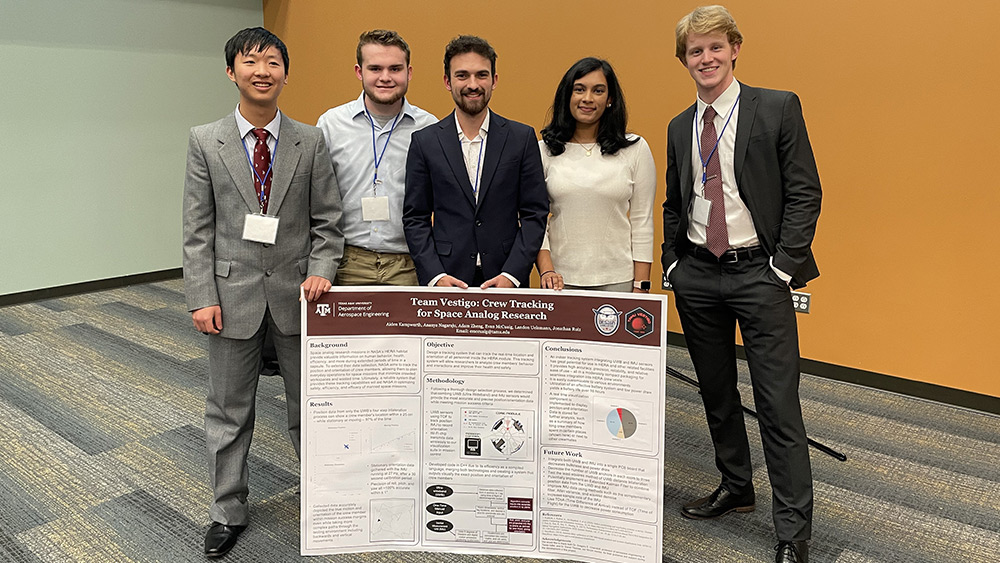
Sponsored by NASA, the Texas Space Grant Consortium Design Challenge is a chance for university teams nationwide to compete for scholarships, helping NASA solve its most pressing issues and develop innovations. Texas A&M University’s very own Team Vestigo, composed of freshmen, took first place against 16 other university teams for their creation of a wearable device to track crew member location and orientation while in space.
“Winning the competition was exhilarating,” said Aiden Kampwerth, who was recently accepted into the Department of Aerospace Engineering at Texas A&M “It wasn’t just that we got sizeable scholarships, but also that all our hard work and sacrifices were worth it. Nothing is more satisfying than knowing everything we did paid off.”
Team Vestigo includes Kampwerth, Landon Uelsmann, Ananya Nagaraju, Evan McCuaig and Adam Zheng.
“This team is different from others — after our team was created, we jumped immediately into working, researching and learning more about each other and the project,” said Nagaraju, a freshman general engineering student who will enter the aerospace engineering department next year. “All of our members are very education driven, meaning we are all driven to learn. We weren’t only focused on winning a prize or making connections.”
The design challenge was developed in response to questions and problems posed by researchers working with NASA on projects within NASA’s Vision for Space Exploration. The work for this challenge was completed over the course of a semester with the help of the team’s faculty advisor, Dr. Gregory E. Chamitoff, who also serves as the William Keeler ’49 Professor of Practice and the director of the Aerospace, Technology, Research and Operations Lab in the aerospace engineering department.
“These challenges push students to explore beyond classroom homework problems and truly design and build something while working with a team,” said Chamitoff. “As such, students develop collaboration skills while actively learning about new technologies, tools and techniques. Such projects connect their engineering academics to real-world applications and further inspire them in their careers.”
There are various projects the teams can choose from for the challenge, ranging from vehicle interchangeable electronic controller network systems to developing a landing zone strategy for lunar base travel.
Team Vestigo decided to develop both hardware and software for a prototype device that can be used to track the exact crew member location and orientation within spaces smaller than 20x20 feet, which could significantly contribute to the analysis of human factors in space.
To accomplish this task, the team used a chip called an Ultra-Wide Band system, which can determine the location of a crew member in the XY plane with a degree of accuracy of 25 centimeters. This system was integrated with an Inertial Measurement Unit (IMU), which a crew member can wear. The IMU can determine which way the crew member is facing with a one-degree margin of error.
In addition to evaluating location and orientation, the data was compiled into a Python visualization script, which provided the ability to retrace a crew member’s steps and assess the amount of time each member spent in a particular area and how long crewmates spent next to each other.
“Over the next decade, we will begin to see astronauts embark on longer journeys to other celestial bodies, creating a need for them to spend months or years in space, which would take a toll on their physical and mental health,” said Kampwerth. “The data provided by our system will help NASA researchers understand how isolated groups interact physically over these long-duration missions by measuring their proximity to each other.”
Once the prototype was developed, the team presented a poster session and delivered a presentation before a panel of judges, which boldly included a live prototype demo.
“The team had a very short time to design, build and program a very novel design for tracking the crew onboard or within ground-based simulations,” said Chamitoff. “They succeeded brilliantly, and winning first place was at least partially due to their amazing presentation.”
The team plans to use the skills they gained during the competition throughout their academic careers and within the aerospace industry.
“This experience helped me learn about the aerospace industry and how to thrive in an engineering job,” said Nagaraju. “I learned how to apply my theoretical knowledge in a practical setting and more about leadership, communication and team building.”